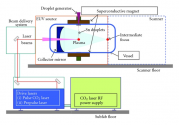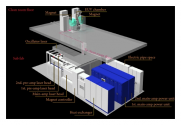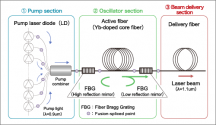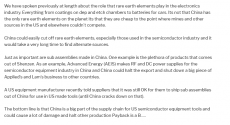For Saudi Arabia and UAE, They can export to china or even have joint venture later, or even hired Chinese to help too.Not a big enough internal market, from what i'm told EUV was actually possible because you had the western and Chinese market consuming consumer electronic that needed sub 7nm nodes.
Will western only markets be enough in the medium future to have multiple 3nm suppliers. Or will the American Intel semi forge eat up all the demand from western chip designers designing 3nm consumer products..
You are using an out of date browser. It may not display this or other websites correctly.
You should upgrade or use an alternative browser.
You should upgrade or use an alternative browser.
Chinese semiconductor industry
- Thread starter Hendrik_2000
- Start date
- Status
- Not open for further replies.
They are different beyond comparison. I don't think there is much expertise to carry. EUV light is generated by ionization of tin. Ionization is achieved by hitting droplets with a CO2 laser.I'd appreciate it if one of the few people here who know what they're talking about like @FairAndUnbiased and @WTAN could shed some light (no pun) on this question: What's the difference between the light source of an LPP EUVL machine and a laser weapon like the Silent Hunter? Both are around the same power, 30 kW for the MOPA lasers ASML uses (and China is rumoured to have recently developed) and 30-100kW quoted for Silent Hunter.


Air defense lasers on the other hand are almost exclusively solid state lasers that work in the near-infrared band.

I think they are talking about the laser that hit the molten tin droplet, not the process itself. But yes, I think the main difference is precision, my guess is that defense lasers just need to destroy the target, its doesn't care about precision, while EUV lasers need convert light energy into plasma-heat energy to deliver light energy with photons of a very precise wavelength at very high repetition rate. A lot of plasma infrastructure needs to be there to that to happen. Which leads me to believe that SSMB could be far superior than LPP once come into fruition.They are different beyond comparison. I don't think there is much expertise to carry. EUV light is generated by ionization of tin. Ionization is achieved by hitting droplets with a CO2 laser.
View attachment 99597View attachment 99598
Air defense lasers on the other hand are almost exclusively solid state lasers that work in the near-infrared band.
View attachment 99601
I think they are talking about the laser that hit the molten tin droplet, not the process itself. But yes, I think the main difference is precision, my guess is that defense lasers just need to destroy the target, its doesn't care about precision, while EUV lasers need convert light energy into plasma-heat energy to deliver light energy with photons of a very precise wavelength at very high repetition rate. A lot of plasma infrastructure needs to be there to that to happen. Which leads me to believe that SSMB could be far superior than LPP once come into fruition.
Air defense laser does care about precision since you need to heat the same spot while the target is maneuvering. However, it does not need anywhere close to the same level of precision we see in high end semi-conductor manufacturing.
Yes. I was wondering why a fiber laser like the Silent Hunter couldn't be substituted for a CO2 laser to illuminate tin droplets. It seems the pulse repetition rates and wavelengths are too different for that to work. In any case it's academic since China has either already developed or is on the cusp of developing a 30kW CO2 MOPA laser to use in its LPP EUVL.I think they are talking about the laser that hit the molten tin droplet, not the process itself.
The 13.5nm story with EUV is because there's a specific energy transition in tin when the electrons fall back into the atom from the plasma and emit a photons of that wavelength. I kind of answered my own question in typing that because these energy levels are all quantized - to strip the electrons (I'm not sure which shells are stripped) the incoming photons have to have sufficient energy (short enough wavelength) for the transition to occur (the photoelectric effect).while EUV lasers need convert light energy into plasma-heat energy to deliver light energy with photons of a very precise wavelength at very high repetition rate.
If the atom needs to absorb a 100nm photon (just a number I pulled out of a hat) to excite an electron to a higher energy level and all the incoming photons are 200nm then it doesn't matter how much of them there are, the transition won't happen.
Very much so. The 13.5nm is set by the quantum properties of tin. The microbunches in SSMB seem to be tunable and able to emit continuous wave light (rather than the pulses in LPP). Furthermore, the optics could be easier to manufacture since different wavelengths could be used and easier to maintain since there would be no tin ash building up.Which leads me to believe that SSMB could be far superior than LPP once come into fruition.
They lose entire Chinese market then. That's the minimum escalation, there's more like secondary sanctions on Apple throughout their supply chain.Let's say china banned micron, but since china is manufacturing powerhouse then what are you going to put into apple's iPhone. Apple won't take ymtc which means you can't build iphone in china which will encourage apple to take out it's iphone to other countries where micron is not banned. Think into consequences of the action.

And Apple profit alot from china’s app store.They lose entire Chinese market then. That's the minimum escalation, there's more like secondary sanctions on Apple throughout their supply chain.


I once heard the ASML CEO say "that their scanners use parts from over that world not just from China", also I think that at least some of ASML research is done in China.
I am pretty confident that the Chinese are smart enough not to disrupt the global supply chain like that guy say they could and much less in the current economic situation, rather they are going to fight this war on their own terms, rather than US terms, like in the Art of War. That is why "United States of America" was not even mentioned once in their congress.
The first causalities looks like that come from friendly fire and those are the Chinese liberals internationalists in the semiconductor industry, the localizers proved that the liberals where wrong all this time and they are going to push for complete domestication. The liberals internationalists are going to fight back with every glimpse of hope the could find and FUD their way in the battlefield. I think that the battle will settle with De-Americanization of the supply chain as much as possible.
This aggregates news of the impact on American semiconductor equipment companies of China sanctions as well as economic downturn.
Interesting excerpt on TEL (Tokyo Electron):
Concluding paragraphs:
Interesting excerpt on TEL (Tokyo Electron):
Data from Tokyo Electron show the company’s total sales of semiconductor production equipment up 2.6 times in the five years to March 2022 (the company’s fiscal year ends in March). The increase was led by a 5.7x increase in China, which grew from 12% to 26% of total sales.
In the two years to March 2022 alone, sales in China increased by 2.7x. That suggests that the Chinese semiconductor industry has purchased enough equipment to see it through the next two or three years, at least.
Tokyo Electron’s performance in other regional markets was not exceptional. Sales were up 2.7x in Korea, 2.6x in the US, 2.5x in Japan, 1.8x in Europe, 1.6x in Taiwan (which started at a high level), and 2.1x in Southeast Asia and other regions.
As Japan’s largest and the world’s third-largest maker of semiconductor production equipment, with a diversified product portfolio, Tokyo Electron is representative of the industry as a whole.
Concluding paragraphs:
The Chinese can no longer rely on US equipment suppliers and European and Japanese suppliers must follow US rules if their products incorporate US technology, so China will step up its .
Sanctions on China have already caused large losses for American semiconductor and equipment companies, and more are probably on the way. Furthermore, in the next up-cycle, the China opportunity for foreign suppliers is likely to be much diminished.
Thanks for posting this. It is so obvious that a large part of the IC supply chain rests with China. It's simply not a great idea for China to use its position to squeeze players further up the chain. China has gained a lot from abusing its "sole supplier" status in the global supply chain. That has allowed it to squeeze out competition. Whereas America build its market dominance at a time when it was close to the only player in the game, China built its market dominance when there were already many other players. The only way you can get and keep market dominance is serve your customers better and cheaper than anyone else.View attachment 99616
I once heard the ASML CEO say "that their scanners use parts from over that world not just from China", also I think that at least some of ASML research is done in China.
I am pretty confident that the Chinese are smart enough not to disrupt the global supply chain like that guy say they could and much less in the current economic situation, rather they are going to fight this war on their own terms, rather than US terms, like in the Art of War. That is why "United States of America" was not even mentioned once in their congress.
The first causalities looks like that come from friendly fire and those are the Chinese liberals internationalists in the semiconductor industry, the localizers proved that the liberals where wrong all this time and they are going to push for complete domestication. The liberals internationalists are going to fight back with every glimpse of hope the could find and FUD their way in the battlefield. I think that the battle will settle with De-Americanization of the supply chain as much as possible.
Only when China has proven it will continue to supply rest of the world with rare earth minerals will producers keep having their minerals refined in China. And as long as China has this market dominance, it can save that leverage when it absolutely needs to use it.
Until then, let's keep an eye on these Chinese equipment bids. It would be shocking for me to see any American companies get picked, but who knows. At this point, even people that love ASML scanner must know that they need to prepare for the possibility that US gov't can force Dutch gov't to stop its sales. I would say that although China cannot really apply pressure on US gov't, it can apply its own pressure on Dutch and Japanese government to keep the sales going. It certainly helps Chinese industries that we are in the middle of a downturn, so these gov't and companies can't be picky about where their sales come from.
- Status
- Not open for further replies.
